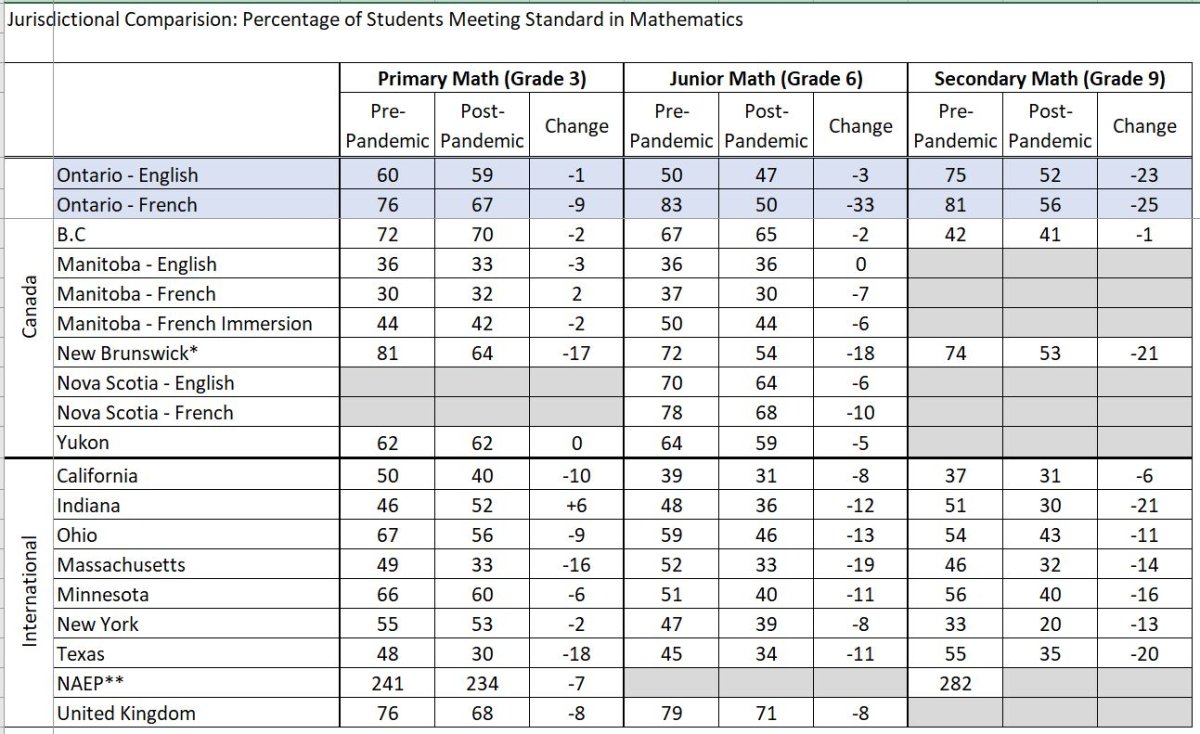The majority of Grade 6 students in Ontario failed the province’s standardized math test, according to new figures obtained by Global News, despite a pledge by the Ford government to boost grades and achievement.

Education Quality and Accountability Office (EQAO) data, obtained by Global News and confirmed by the Ministry of Education, also shows math test scores for the 2021-2022 school year have not substantially improved since 2018 — when Premier Doug Ford took office and promised change.
The latest data shows 59 per cent of Grade 3 students met the provincial mathematics standard. Just 47 per cent of Grade 6 students met the threshold, while 52 per cent of Grade 9 students were at the standard.
The test, however, was administered during unprecedented disruption in the education system due to COVID-19.
During the pandemic, the Ford government was forced to close schools for a total of 20 weeks. Those closures, Ontario’s Minister of Education maintains, may have had an impact on the results.
“The pandemic took kids out of school and created mass disruption,” said Education Minister Stephen Lecce in an exclusive interview with Global News. “In every region of the world, math and literacy are regressing.”
“Learning loss is a real trend and a phenomena,” Lecce said.

Vanessa Vakharia, who operates a tutoring company called the Math Guru, has seen it first-hand.
“What we’re seeing is an increase in the anxiety as a result of any gaps in education,” Vakharia told Global News. “We’re getting a lot more calls related to ‘my kid has lost confidence, they’re scared of asking questions, they feel really anxious in math class.”
Vakharia said, however, she’s still concerned to see test scores so low.
“I do think it is concerning that 53 per cent of kids are not meeting the provincial average.”
Political calculation
Low EQAO scores in Ontario schools have long been the focus of Doug Ford’s scorn. The PC leader campaigned against the former Liberal government on education, turning the math curriculum into a line of attack.
“Kids used to learn math by doing things like memorizing a multiplication table, and it worked,” Ford said during the 2018 election campaign.
“Instead, our kids are left with experimental discovery math. That hardly teaches math at all. Instead, everyone gets a participation ribbon and our kids are left to fend for themselves.”

Soon after entering Queen’s Park, Premier Ford pledged to overhaul the math curriculum and told the Ontario Legislature that when “half our students are failing math, we have an issue.”
Almost two years later, on the eve of the COVID-19 pandemic, Ford promised his government was on the cusp of delivering improved math scores for Ontario students.
“We’re turning the corner with education,” he said on March 5, 2020. “Again, rather than having our students with the lowest math scores in the country — 50 per cent of them are failing … We’re finally turning the corner.”
- Oil spill that shut Toronto subway line for almost a day not an isolated incident: TTC
- Faqiri family calls out Ontario government for lack of action on inquest recommendations
- Victoria Day fireworks: Where they will be blasting off in Toronto
- ‘Crypto King’ arrest: Ontario police fear more victims in ‘massive’ fraud case
However, the new data shows almost no progress has been made. The 2021-22 math scores are nearly identical when compared to the 2018-19 academic year in which Ford was first elected.
In 2018, 58 per cent of Grade 3 students met the provincial standard (compared to 59 in 2021-22) and a total of 48 per cent in Grade 6 (compared to 47 per cent in the latest results).
The results are even worse when compared to earlier years. Between 2015 and 2017, EQAO Grade 6 math scores were at 50 per cent, dropping to 49 per cent in 2017-2018.
Lecce maintains the “crux of the challenge” remains the pandemic disruption, not the government’s policies on education.
The province offered data comparing Ontario to other Canadian provinces and American states where math testing scores also dropped.
Plan to catch up
The government said the data was a bump in the road — and highlighted its plans to help children catch up after COVID-19 disruptions.
The province’s so-called “Plan to catch up” includes money to fund additional tutoring for students at home and an increase in summer learning.
More than $175 million was pegged to be spent on tutoring support programs offered by “school boards and community partners, with a focus on reading, writing and math.”
A total of $304 million in one-time funding for additional front-line staff such as teachers and early childhood educators was part of the package promised in July.
The government is also set to unveil more details this week about a $365 million direct support payment to parents for private tutoring enrollment.
Where do we go from here?
Lecce says his government has a three-year math strategy to “improve scores” along with training for educators and supports for students.
The minister, however, would not set a target for what percentage of students would be at or above the provincial average at full implementation.
“We will do a whole lot of good so that every student, 100 per cent of students, perform a whole lot better. That’s the vision,” Lecce told Global News.
Vakharia, meanwhile, said the province needs to focus on slimming down class sizes, allowing students to have more interaction with educators on complex subjects.
“We need to lower the ratio between the educators and the students,” Vakharia said. “Because if a student has a question in a classroom of 30 it’s impossible, there’s no way they’re going to get that support from the teacher.”







Comments